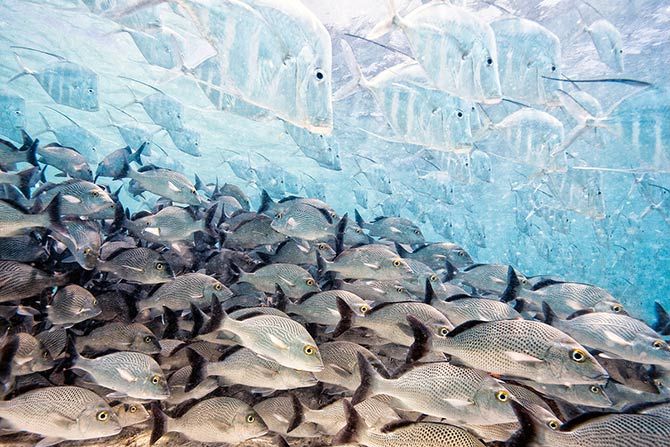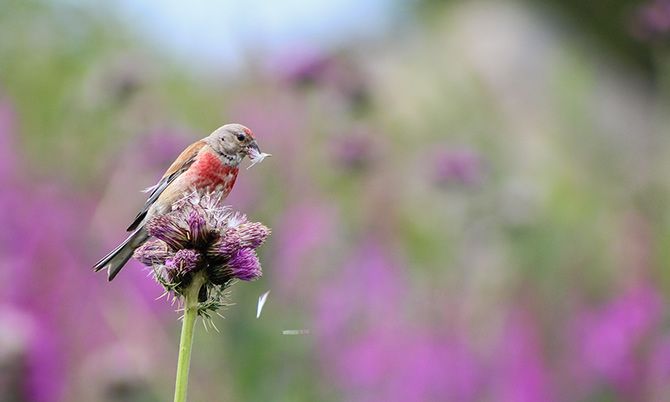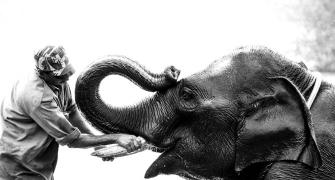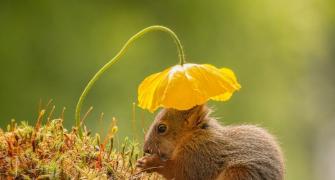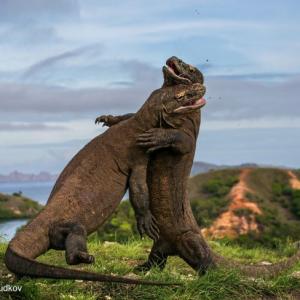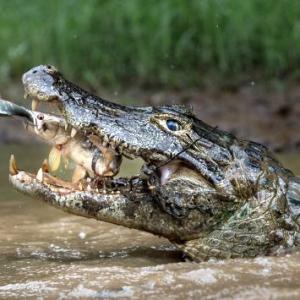 A curious fox cub, an inquisitive orca all play starring roles in images from the finalists of Wildlife Photographer of the Year’s fifty-second competition.
A curious fox cub, an inquisitive orca all play starring roles in images from the finalists of Wildlife Photographer of the Year’s fifty-second competition.
The world-renowned exhibition opens on October 21 at the Natural History Museum in London, which runs the annual competition.
Scroll below to have your mind blown by the amazing photography.
Please click on the photos to view hi-resolution images.
Blast Furnace
Alexandre Hec, France
When the lava flow from Kilauea on Hawaii’s BigIsland periodically enters the ocean, the sight is spectacular, but on this occasion Alexandre was in for a special treat. Kilauea (meaning ‘spewing’ or ‘much spreading’) is one of the world’s most active volcanoes, in constant eruption since 1983. As red-hot lava at more than 1,000?C flows into the sea, vast plumes of steam hiss up, condensing to produce salty, acidic mist or rain. Photograph: Alexandre Hec/Wildlife Photographer of the Year 2016
Splitting the catch
Audun Rikardsen, Norway
Sometimes it’s the fishing boats that look for the killer whales and humpbacks, hoping to locate the shoals of herring that migrate to these Arctic Norwegian waters. But in recent winters, the whales have also started to follow the boats. Here a large male killer whale feeds on herring that have been squeezed out of the boat’s closing fishing net. He has learnt the sound that this type of boat makes when it retrieves its gear and homed in on it. The relationship would seem to be a win-win one, but not always. Photograph: Audun Rikardsen/Wildlife Photographer of the Year 2016
Golden relic
Dhyey Shah, India
With fewer than 2,500 mature adults left in the wild, in fragmented pockets of forest in northeastern India (Assam) and Bhutan, Gee’s golden langurs are endangered. Living high in the trees, they are also difficult to observe. But, on the tiny man-made island of Umananda, in Assam’s BrahmaputraRiver, you are guaranteed to see one. Site of a temple dedicated to the Hindu god Shiva, the island is equally famous for its introduced golden langurs. Within moments of stepping off the boat, Dhyey spotted the golden coat of a langur high up in a tree. The monkey briefly made eye contact and then slipped away. Photograph: Dhyey Shah/Wildlife Photographer of the Year 2016
The disappearing fish
Iago Leonardo, Spain
In the open ocean, there’s nowhere to hide, but the lookdown fish -- a name it probably gets from the steep profile of its head, with mouth set low and large eyes high -- is a master of camouflage. Recent research suggests that it uses special platelets in its skin cells to reflect polarised light (light moving in a single plane), making itself almost invisible to predators and potential prey. The platelets scatter polarized light depending on the angle of the sun and the fish, doing a better job than simply reflecting it like a mirror. Photograph: Iago Leonardo/Wildlife Photographer of the Year 2016
Swarming under the stars
Imre Potyó, Hungary
Imre was captivated by the chaotic swarming of mayflies on Hungary’s River Rába and dreamt of photographing the spectacle beneath a starlit sky. For a few days each year (at the end of July or beginning of August), vast numbers of the adult insects emerge from the Danube tributary, where they developed as larvae. On this occasion, the insects emerged just after sunset. At first, they stayed close to the water, but once they had mated, the females gained altitude. Photograph: Imre Potyó/Wildlife Photographer of the Year 2016
Thistle-plucker
Isaac Aylward, UK
Try keeping a flying linnet in sight while scrambling down rocky embankments holding a telephoto lens. Isaac did, for 20 minutes. He was determined to keep pace with the linnet that he spotted while hiking in Bulgaria’s RilaMountains, finally catching up with the tiny bird when it settled to feed on a thistle flowerhead. From the florets that were ripening, it pulled out the little seed parachutes one by one, deftly nipped off the seeds and discarded the feathery down. Photograph: Isaac Aylward/Wildlife Photographer of the Year 2016
Playing pangolin
Lance van de Vyver, New Zealand/South Africa
Lance had tracked the pride for several hours before they stopped to rest by a waterhole, but their attention was not on drinking. The lions (in South Africa’s Tswalu Kalahari Private Game Reserve) had discovered a Temminck’s ground pangolin. This nocturnal, ant-eating mammal is armour-plated with scales made of fused hair, and it curls up into an almost impregnable ball when threatened. Pangolins usually escape unscathed from big cats (though not from humans, whose exploitation of them for the traditional medicine trade is causing their severe decline). But these lions just wouldn’t give up. ‘They rolled it around like a soccer ball,’ says Lance. ‘Every time they lost interest, the pangolin uncurled and tried to retreat, attracting their attention again.’ Photograph: Lance van de Vyver/Wildlife Photographer of the Year 2016
Crystal precision
Mario Cea, Spain
Every night, not long after sunset, about 30 common pipistrelle bats emerge from their roost in a derelict house in Salamanca, Spain, to go hunting. Each has an appetite for up to 3,000 insects a night, which it eats on the wing. Its flight is characteristically fast and jerky, as it tunes its orientation with echolocation to detect objects in the dark. The sounds it makes -- too high?pitched for most humans to hear -- create echoes that allow it to make a sonic map of its surroundings. Mario positioned his camera precisely so that it was level with the bats’ exit through a broken window and the exact distance away to capture a head-on shot. Photograph: Mario Cea/Wildlife Photographer of the Year 2016
Nosy neighbour
Sam Hobson, UK
Sam knew exactly who to expect when he set his camera on the wall one summer’s evening in a suburban street in Bristol, the UK’s famous fox city. He wanted to capture the inquisitive nature of the urban red fox in a way that would pique the curiosity of its human neighbours about the wildlife around them. This was the culmination of weeks of scouting for the ideal location -- a quiet, well?lit neighbourhood, where the foxes were used to people (several residents fed them regularly) -- and the right fox. For several hours every night, Sam sat in one fox family’s territory, gradually gaining their trust until they ignored his presence. One of the cubs was always investigating new things – his weeping left eye the result of a scratch from a cat he got too close to.
Photograph: Sam Hobson/Wildlife Photographer of the Year 2016
Collective courtship
Scott Portelli, Australia
Thousands of giant cuttlefish gather each winter in the shallow waters of South Australia’s Upper Spencer Gulf for their once-in-a-lifetime spawning. Males compete for territories that have the best crevices for egg?laying and then attract females with mesmerizing displays of changing skin colour, texture and pattern. Rivalry among the world’s largest cuttlefish -- up to a metre (3.3 feet) long -- is fierce, as males outnumber females by up to eleven to one. A successful, usually large, male grabs the smaller female with his tentacles, turns her to face him (as here) and uses a specialized tentacle to insert sperm sacs into an opening near her mouth. He then guards her until she lays the eggs. The preoccupied cuttlefish (the male on the right) completely ignored Scott, allowing him to get close. Photograph: Scott Portelli/Wildlife Photographer of the Year 2016
Termite tossing
Willem Kruger, South Africa
Termite after termite after termite -- using the tip of its massive beak-like forceps to pick them up, the hornbill would flick them in the air and then swallow them. Foraging beside a track in South Africa’s semi-arid Kgalagadi Transfrontier Park, the southern yellow-billed hornbill was so deeply absorbed in termite snacking that it gradually worked its way to within 6 metres (19 feet) of where Willem sat watching from his vehicle. Photograph: Willem Kruger/Wildlife Photographer of the Year 2016




